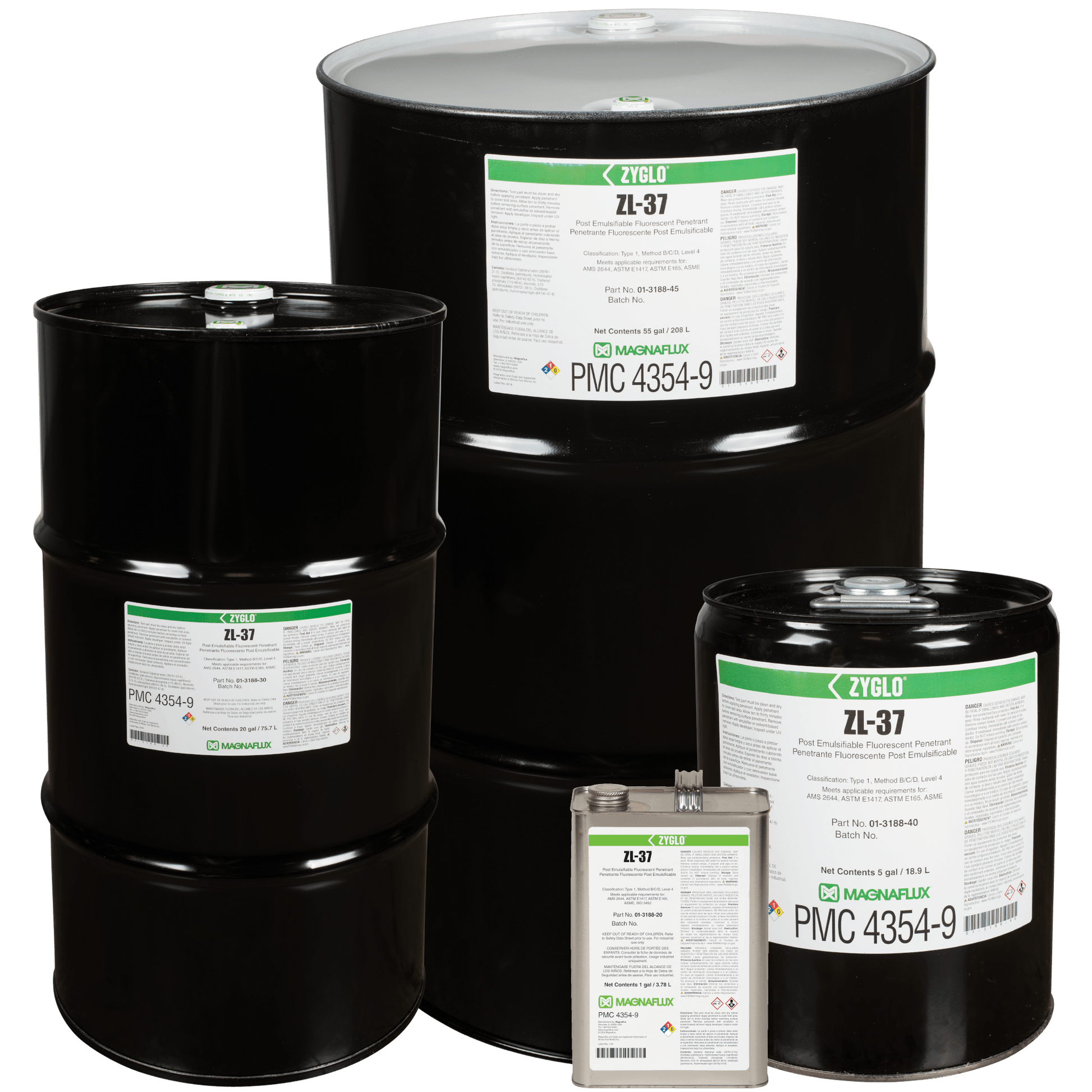





Essential for critical component applications, ultra-high sensitivity ZL-37 post-emulsifiable penetrant is designed for detecting fine, tight discontinuities in safety-critical components, such as titanium turbine components, and in high-stress parts, such as investment castings.
This Type 1 penetrant is non-water-soluble so there is minimal risk of washing ZL-37 penetrant from a fine or shallow defect which makes this penetrant inspection the most reliable, dependable form of PT testing. ZL-37 has a high flash point and provides long tank life when used in open dip tanks, but this penetrant can also be applied in a variety of other ways, including electrostatic spray.
ZL-37 can be removed with ZE-4E Method B lipophilic emulsifier or ZR-10E Method D hydrophilic emulsifier.
ZL-37 is listed on the QPL SAE AMS 2644 Qualified Product List and is approved for use by Pratt & Whitney.
Benefits
Improve indication detection in the most critical applications
- Creates the clearest, brightest indications for even the finest flaws due to very strong UV and thermal stability
- Highest fluorescent brightness of any Level 4 penetrant for high-contrast indications that are easy for inspectors to see – even when the indications are very small
- Indications stand out more since background fluorescence is minimized; emulsifiers only remove surface penetrant without the risk of over-washing
Maximize penetrant inspection process control
- Prevents over-washing since ZL-37 cannot be removed with water (unless combined with an emulsifier)
- PE penetrant system is less susceptible to human error since only surface penetrant is removed in the final rinse stage
Wide range of inspections
- Inspect a wide range of high-value components without fear of corrosion or specification non-conformance
- Meets all major industry and NDT specification requirements, including Aerospace Prime and OEM specs, AMS 2644 and ISO 3452
Maximize operator comfort and safety
- Promotes better inspection quality by providing the operator with a more comfortable work environment
- Reduces discomfort from strong odors
- Exceeds all EHS requirements
Features
- Level 4 ultra-high sensitivity
- Post emulsifiable
- Bright, high-contrast indications
- Resists over-washing or over-removal
- High flash point
- Wide range of application methods
- Low odor
- Very low toxicity
- Alloy compatibility
- Very high thermal resistance
- Very high UV stability
- High dye content
- QPL SAE AMS 2644 Qualified Product List
- Approved for use by Pratt & Whitney
Specifications
- AECL
- AMS 2644
- ASME BPVC
- ASTM E1417
- ASTM E165
- Boeing BAC 5423 PSD 6-46 or 8-4
- Boeing PS-21202
- ISO 3452
- MIL-STD-2132
- MIL-STD-271
- Navsea T9074-AS-GIB-010/271
- Pratt & Whitney PMC 4354
- QPL SAE AMS 2644
Applications
Defect location: open to surface
Ideal for:
- Detecting fine to very-fine discontinuities
- Precision components
- Safety-critical components
- Investment castings
- High-stress parts
- Smooth, machined surface finish
- Non-porous surfaces
- Finding wide, shallow flaws
- Turbine engine blades, disks, etc.
- Titanium
- Aluminum
- Immersion dip tank
- Electrostatic spray
Defect examples:
- Finished surface cracks
- Seams
- Porosity
- Scratches
Use Recommendations
NDT Method: Fluorescent Penetrant Testing
Type: Type 1
Methods: Method B, Method C or Method D
Sensitivity Level: Level 4, ultra-high sensitivity
Required Equipment: UV light source, like the EV6000
Temperature Range: 40 to 125°F / 4 to 52°C






